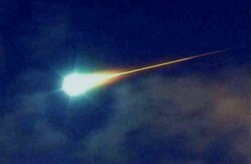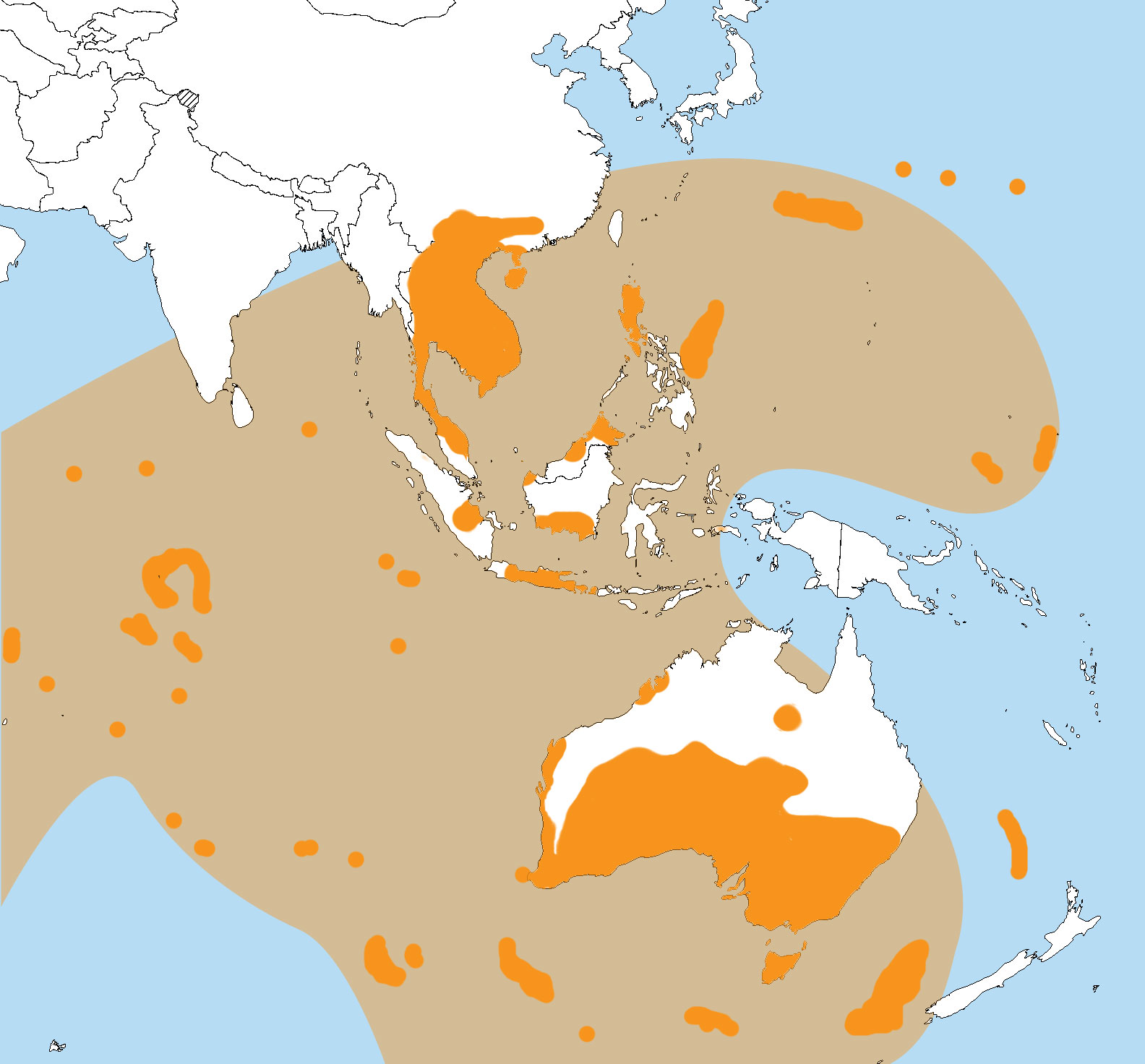|
Strewnfield
The term strewn field indicates the area where meteorites from a single fall are dispersed. It is also often used for the area containing tektites produced by large meteorite impact.''Tektites in the geological record: showers of glass from the sky''. Gerald Joseph Home McCall. Geological Society of London, 2001page 10/ref> Formation There are two strewnfield formation mechanisms: # Mid-air fragmentation: when a large meteoroid enters the atmosphere it often fragments into many pieces before touching the ground due to thermal shock. This mid-air explosion disperses material over a large oval-shaped area. The long axis of this oval is along the flight path of the meteoroid. When multiple-explosions occur, the material can be found in several overlapping ovals. # Impact fragmentation: when there is almost no mid-air fragmentation the fragmentation can occur upon impact. In this case the strewnfield shape can be different, usually circular. (e.g. Canyon Diablo at Meteor Crater; Austra ... [...More Info...] [...Related Items...] OR: [Wikipedia] [Google] [Baidu] |
Meteorite
A meteorite is a solid piece of debris from an object, such as a comet, asteroid, or meteoroid, that originates in outer space and survives its passage through the atmosphere to reach the surface of a planet or Natural satellite, moon. When the original object enters the atmosphere, various factors such as friction, pressure, and chemical interactions with the atmospheric gases cause it to heat up and radiate energy. It then becomes a meteor and forms a Meteoroid#Fireball, fireball, also known as a shooting star; astronomers call the brightest examples "Bolide#Astronomy, bolides". Once it settles on the larger body's surface, the meteor becomes a meteorite. Meteorites vary greatly in size. For geologists, a bolide is a meteorite large enough to create an impact crater. Meteorites that are recovered after being observed as they transit the atmosphere and Impact event, impact the Earth are called meteorite falls. All others are known as meteorite finds. Meteorites have traditiona ... [...More Info...] [...Related Items...] OR: [Wikipedia] [Google] [Baidu] |
Meteorite Fall
A meteorite fall, also called an observed fall, is a meteorite collected after its fall from outer space was observed by people or automated devices. Any other meteorite is called a "find". There are more than 1,100 documented falls listed in widely used databases, most of which have specimens in modern collections. , the Meteoritical Bulletin Database had 1211 confirmed falls. Importance Observed meteorite falls are important for several reasons. Material from observed falls has not been subjected to terrestrial weathering, making the find a better candidate for scientific study. Historically, observed falls were the most compelling evidence supporting the extraterrestrial origin of meteorites. Furthermore, observed fall discoveries are a better representative sample of the types of meteorites which fall to Earth. For example, iron meteorites take much longer to weather and are easier to identify as unusual objects, as compared to other types. This may explain the increas ... [...More Info...] [...Related Items...] OR: [Wikipedia] [Google] [Baidu] |
Gunter Faure
Gunter Faure is a geochemist who currently holds the position of Professor Emeritus in the School of Earth Science of Ohio State University. He obtained his PhD from the Massachusetts Institute of Technology The Massachusetts Institute of Technology (MIT) is a private land-grant research university in Cambridge, Massachusetts. Established in 1861, MIT has played a key role in the development of modern technology and science, and is one of the ... in 1961. Books *''Introduction to Planetary Science: The Geological Perspective'', Gunter Faure and Teresa M. Mensing, Springer, 2007, 526 pp. *''Isotopes: Principles and Applications'', Gunter Faure and Teresa M. Mensing, Wiley; 3rd edition, 2005. *''Origin of Igneous Rocks: The Isotopic Evidence'', Gunter Faure, Springer, 2000, 496 pp. (2010 reprint ) *''Principles and Applications of Geochemistry'', Gunter Faure, Prentice Hall, 1998, 2nd Ed., 625 pp. *''Principles and Applications of Inorganic Geochemistry'', Gunter Faure, ... [...More Info...] [...Related Items...] OR: [Wikipedia] [Google] [Baidu] |
Tektite
Tektites (from grc, τηκτός , meaning 'molten') are gravel-sized bodies composed of black, green, brown or grey natural glass formed from terrestrial debris ejected during meteorite impacts. The term was coined by Austrian geologist Franz Eduard Suess (1867–1941), son of Eduard Suess. They generally range in size from millimetres to centimetres. Millimetre-scale tektites are known as microtektites.French, B. M. (1998) ''Traces of Catastrophe: A Handbook of Shock-Metamorphic Effects in Terrestrial Meteorite Impact Structures.'' LPI Contribution No. 954. Lunar and Planetary Institute, Houston, Texas. 120 pp.McCall, G. J. H. (2001) ''Tektites in the Geological Record: Showers of Glass from the Sky.'' The Geological Society Publishing House, Bath, United Kingdom. 256 pp. Montanari, A., and C. Koeberl (2000) ''Impact Stratigraphy. The Italian Record.'' Lecture Notes in Earth Sciences Series no. 93. Springer-Verlag, New York, New York. 364 pp. Tektites are characterized by: # ... [...More Info...] [...Related Items...] OR: [Wikipedia] [Google] [Baidu] |
Meteoroid
A meteoroid () is a small rocky or metallic body in outer space. Meteoroids are defined as objects significantly smaller than asteroids, ranging in size from grains to objects up to a meter wide. Objects smaller than this are classified as micrometeoroids or space dust. Most are fragments from comets or asteroids, whereas others are collision impact debris ejected from bodies such as the Moon or Mars. When a meteoroid, comet, or asteroid enters Earth's atmosphere at a speed typically in excess of , aerodynamic heating of that object produces a streak of light, both from the glowing object and the trail of glowing particles that it leaves in its wake. This phenomenon is called a meteor or "shooting star". Meteors typically become visible when they are about 100 km above sea level. A series of many meteors appearing seconds or minutes apart and appearing to originate from the same fixed point in the sky is called a meteor shower. A meteorite is the remains of a meteoroid th ... [...More Info...] [...Related Items...] OR: [Wikipedia] [Google] [Baidu] |
Atmosphere
An atmosphere () is a layer of gas or layers of gases that envelop a planet, and is held in place by the gravity of the planetary body. A planet retains an atmosphere when the gravity is great and the temperature of the atmosphere is low. A stellar atmosphere is the outer region of a star, which includes the layers above the opaque photosphere; stars of low temperature might have outer atmospheres containing compound molecules. The atmosphere of Earth is composed of nitrogen (78%), oxygen (21%), argon (0.9%), carbon dioxide (0.04%) and trace gases. Most organisms use oxygen for respiration; lightning and bacteria perform nitrogen fixation to produce ammonia that is used to make nucleotides and amino acids; plants, algae, and cyanobacteria use carbon dioxide for photosynthesis. The layered composition of the atmosphere minimises the harmful effects of sunlight, ultraviolet radiation, the solar wind, and cosmic rays to protect organisms from genetic damage. The current comp ... [...More Info...] [...Related Items...] OR: [Wikipedia] [Google] [Baidu] |
Canyon Diablo (canyon)
Canyon Diablo ( Navajo: Kin Łigaaí) is a canyon near Two Guns in Northern Arizona. Part of it is located on the Navajo Nation. Discovery Canyon Diablo was named by U.S. Army Lieutenant Amiel Weeks Whipple. Whipple, of the Army's Topographical Engineers, made a survey in 1853–1854 along the 35th parallel. In mid December 1853 Whipple found a steep canyon while riding west from a point near Winslow with a reconnaissance party. He named it Canyon Diablo. The canyon passes west of Meteor Crater. The community of Canyon Diablo, Arizona on the edge of the canyon about northwest of the crater was the closest community to the crater when scientists began investigating the crater. Consequently, the meteorite that caused the crater is officially called the Canyon Diablo meteorite. Canyon Diablo ("devil canyon") is the Spanish translation of the Native American name. The Canyon Diablo Bridge, once used by U.S. Route 66 to cross the canyon south of the present I-40 bridges, ... [...More Info...] [...Related Items...] OR: [Wikipedia] [Google] [Baidu] |
Meteor Crater
Meteor Crater, or Barringer Crater, is a meteorite impact crater about east of Flagstaff and west of Winslow in the desert of northern Arizona, United States. The site had several earlier names, and fragments of the meteorite are officially called the Canyon Diablo Meteorite, after the adjacent Cañon Diablo. Because the United States Board on Geographic Names recognizes names of natural features derived from the nearest post office, the feature acquired the name of "Meteor Crater" from the nearby post office named Meteor. Meteor Crater lies at an elevation of above sea level. It is about in diameter, some deep, and is surrounded by a rim that rises above the surrounding plains. The center of the crater is filled with of rubble lying above crater bedrock. One of the interesting features of the crater is its squared-off outline, believed to be caused by existing regional jointing (cracks) in the strata at the impact site. Despite historic attempts to make the crater ... [...More Info...] [...Related Items...] OR: [Wikipedia] [Google] [Baidu] |
Australasian Strewnfield
The Australasian strewnfield is the youngest and largest of the tektite strewnfields, with recent estimates suggesting it might cover 10%–30% of the Earth's surface.Glass, B.P. and Wu, J., 1993. ''Coesite and shocked quartz discovered in the, Australasian and North American, microtektite layers.'' ''Geology'', 21(5), pp.435-438.Prasad, M.S., Gupta, S.M. and Kodagali, V.N., 2003. ''Two layers of Australasian impact ejecta in the Indian Ocean?.'' ''Meteoritics & Planetary Science'', 38(9), pp.1373-1381.Prasad, M.S., Mahale, V.P. and Kodagali, V.N., 2007. ''New sites of Australasian microtektites in the central Indian Ocean: Implications for the location and size of source crater.'' ''Journal of Geophysical Research: Planets'', 112, no. E06007, 11 pp. Research indicates that the impact forming the tektites occurred around 788,000 years ago, most likely in Southeast Asia.Jourdan, F., Nomade, S., Wingate, M.T., Eroglu, E. and Deino, A., 2019. ''Ultraprecise age and formation temperatur ... [...More Info...] [...Related Items...] OR: [Wikipedia] [Google] [Baidu] |
Weather Radar
Weather radar, also called weather surveillance radar (WSR) and Doppler weather radar, is a type of radar used to locate precipitation, calculate its motion, and estimate its type (rain, snow, hail etc.). Modern weather radars are mostly pulse-Doppler radars, capable of detecting the motion of rain droplets in addition to the intensity of the precipitation. Both types of data can be analyzed to determine the structure of storms and their potential to cause severe weather. During World War II, radar operators discovered that weather was causing echoes on their screen, masking potential enemy targets. Techniques were developed to filter them, but scientists began to study the phenomenon. Soon after the war, surplus radars were used to detect precipitation. Since then, weather radar has evolved on its own and is now used by national weather services, research departments in universities, and in television stations' weather departments. Raw images are routinely used and speciali ... [...More Info...] [...Related Items...] OR: [Wikipedia] [Google] [Baidu] |
Terminal Velocity
Terminal velocity is the maximum velocity (speed) attainable by an object as it falls through a fluid (air is the most common example). It occurs when the sum of the drag force (''Fd'') and the buoyancy is equal to the downward force of gravity (''FG'') acting on the object. Since the net force on the object is zero, the object has zero acceleration. In fluid dynamics an object is moving at its terminal velocity if its speed is constant due to the restraining force exerted by the fluid through which it is moving. As the speed of an object increases, so does the drag force acting on it, which also depends on the substance it is passing through (for example air or water). At some speed, the drag or force of resistance will equal the gravitational pull on the object (buoyancy is considered below). At this point the object stops accelerating and continues falling at a constant speed called the terminal velocity (also called settling velocity). An object moving downward faster than ... [...More Info...] [...Related Items...] OR: [Wikipedia] [Google] [Baidu] |






